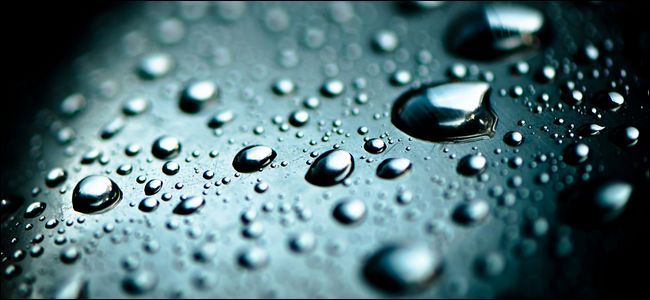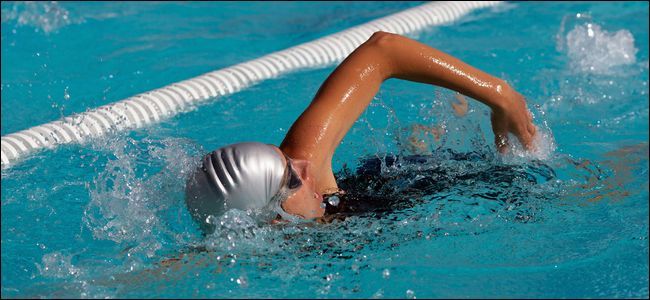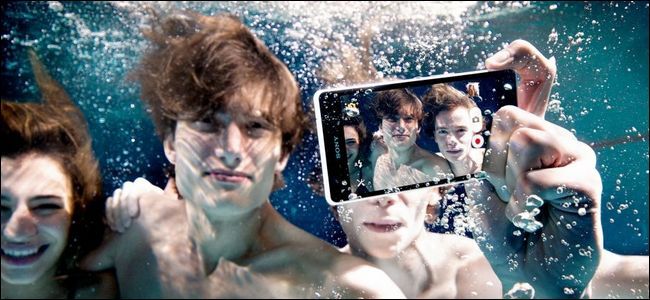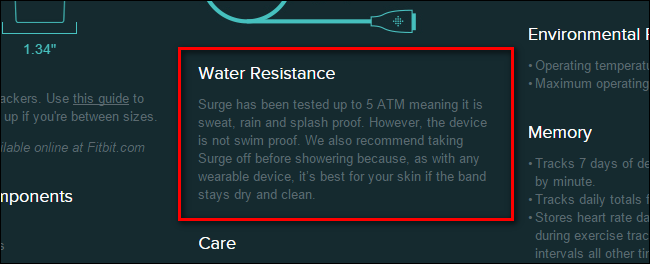Quick Links
Your new smartwatch claims to be waterproof, your fitness tracker claims to be water resistant, and your smartphone's manufacturer advertises their phone working in a glass of water, yet all three of those devices might not survive a trip into a swimming pool. Read on as we untangle the advertising jargon and explain what water resistance really means.
The entire market for water-resistant and "waterproof" gadgets is rife with labels and ratings (many of which are loosely or poorly applied) combined with a heaping pile of (well earned) consumer confusion. If you're searching for help decoding what the water-resistance rating of your device means or currently trying to dry out a device you mistakenly took to the pool this is the article for you.
If you're in the hurry and you need the ten second summary of it all, well you're in luck, we've got an easy to digest takeaway right at hand: There is no such thing as a waterproof device, water-resistance is a dicey proposition at best, and when in doubt treat any claims of water-resistance as insurance against an unexpected rain storm and not an invitation to go high diving with your device.
The Rise of Water Resistant Gadgets
Historically water resistance was the province of extreme sports and gear companies. Outside of watches intended for deep sea divers or triathletes there wasn't much need for serious protection against water; most people were just happy if their Timex didn't give up the ghost after a run in with the rain. The market for water resistant computers and the like was even smaller: very few people needed a laptop that could survive a fall from a truck or a dunk in a river.
Widespread adoption of smartphones and wearables has changed the face of the entire water resistance market, however, as now people are taking very expensive devices places where a little water is a big problem. Nobody wants to fry their new smartwatch at the beach and if you're supposed to wear your fitness tracker 24/7 it certainly needs to survive at least a daily trip into the shower with you.
Unfortunately for the consumer the terms and advertising methods used by these companies range from honest with a little spin to unclear to outright disingenuous. Fortunately, on the other hand, there are clear formal and informal international standards for testing water resistance and as an informed consumer you can cut through the advertising nonsense, read the spec sheet yourself, and see exactly how well your device will fare under various conditions.
Mobile gadgets like phones, cameras, and other devices are typically rated with an Ingress Protection (IP) rating whereas smart watches and wearables like fitness trackers are typically rated using a an Atmospheres (ATM) rating. Understanding what these two ratings entail is key to selecting the right device (and keeping the devices you have safe and functioning).
Before we proceed into the nitty gritty of what "water resistance" even entails we want to highlight one very important thing that you should always keep in mind when dealing with such gadgets. Water resistant isn't waterproof.
In fact, in the world of consumer electronics, there is no such thing as waterproof. Every product, no matter how carefully engineered, has a failure point. Every smartphone, every smartwatch, every wearable, every "waterproof" camera, every single device, has a point where a combination of water temperature, depth, length of exposure, or manipulation of the device while submerged, will lead to a failure of the water resisting mechanism(s) and the device will no longer be water resistant.
We'd even go so far as to say that not only is there no such thing as waterproof but that even most cases of "water resistant" are poor: poorly marketed, poorly understood, and they work poorly under real world conditions.
Let's start off by talking about the ATM rating as it is the most common and the most applicable to wearable devices, then we'll discuss IP ratings, and take a look at how both of these ratings apply in real life (and what you can do in the event of device failure).
Decoding the ATM Rating
Long before people were even contemplating taking cameras in pools and phones out on a jet ski ride, people were most definitely wearing their wristwatches to the beach. The ATM rating is a long standing rating used to denote the how much static atmospheric pressure a device can endure when submerged. The higher the atmosphere rating the deeper the device can go as deeper water exerts more pressure.
The ATM pressure/water resistance rating is the one you'll find on regular mechanical and battery driven watches and that you'll most likely to find on new wearables products like the Pebble Smartwatch, the Misfit Shine, and the Fitbit Surge.
One ATM translates to the static pressure exerted by static submersion in 10 meters of water. The following chart outlines common ATM ratings for consumer watches and wearables. Because the meter rating is easily translated from ATM to meters (1ATM = 10 Meters) we've given the "resistance to" value in feet for the convenience of non-metric system readers.
A tiny science-aside is in order to help you decode the chart. When you're at sea level you're already at 1 ATM. This is why a device with a 1 ATM rating offers no submersion protection or general water resistance. Simply putting a device under the very surface of body of water immediately exposes it to a slight increase in pressure and for many devices that's more than enough to allow water to ingress.
Further these ratings, as we mentioned, are for static pressure. This means if the device is sitting perfectly still in a test chamber it can endure pressure up to the rated value and then, upon removal from the test chamber it will function. Any application of dynamic pressure caused by movement of the wearer (such as swimming, diving into a pool, falling off a jet ski, etc.) increases the pressure of water exposure. This is why a watch that is rated for 3 ATM and would survive a rainstorm just fine will end up damaged if it is sprayed with a high-pressure water hose. Not all water exposure is equal!
|
Rating |
Pressure |
Suitable Use / Precautions |
|---|---|---|
|
1 ATM |
--- |
Poor water resistance. Device should be kept away from water. |
|
3 ATM |
~100 feet |
Suitable for every day use. Protected against splashes, rain, water exposure during hand washing, and so on. Do not use for swimming. |
|
5 ATM |
~165 feet |
Suitable for short periods of submersion like light swimming. |
|
10 ATM |
~330 feet |
Suitable for extended periods of submersion like one would experience snorkeling. |
|
20 ATM |
~660 feet |
Suitable for high impact water sports like surfing, jet skiing, and shallow dive trips. |
|
Diver |
660+ feet |
Rated dive watches are governed by and rated by ISO 6425 and outside the scope of this article. |
The ATM rating is unofficial in the sense that there is not an official body that conducts ATM tests and enforces adherence to guidelines. Watches or wearables rated from 1-20 ATM are labeled as such by the manufacturer and not always labeled in a way that adheres with the common conventions used by other manufacturers.
Unfortunately the ATM rating is misappropriated and misapplied in many cases; let's take a look at the other common rating standard before we dig into applying the ratings in the real world (and why you should be a very cautious consumer).
Decoding the IP Rating
The international standard is the Ingress Protection (IP) Rating. Unlike unspecific claims made by manufacturers and their potentially confusing advertising images, the IP rating of given to a device is very specific and backed by controlled tests. If the IP rating is not provided by a manufacturer you should take their claims with a grain of salt (and certainly read the manual very carefully to see what water resistance, if any, the device is supposed to have).
The device in question might be water resistant but you have no real way of knowing how water resistant it is. Perhaps the company didn't want to pay for the testing and certification or perhaps they knew it would receive a poor rating and opted to simply advertise it as water resistant sans an official IP rating.
IP rating designations are given in the format IPXY where X is a rating for physical ingress (how resistant the device is to penetration by everything from fingers to particles of dust) and Y is the rating for liquid ingress (how resistant is to penetration by liquids under conditions ranging from misting to deep submersion). The rating number given for each category indicates that the device in question has met the requirements for each previous rating (e.g. a device that is rated IP68 has passed the rating requirements for all six physical ingress levels and the first eight liquid ingress levels).
Let's take a look at both values. Although this article is focused on understanding water resistance, smartphone and wearable manufacturers do reference the physical ingress rating too when talking about protection from sand and dust.
The IP rating table for protection against physical ingress is as follows. Table courtesy of Wikipedia.
|
Level |
Object size protected against |
Effective against |
|---|---|---|
|
0 |
--- |
No protection against contact and ingress of objects |
|
1 |
>50 mm |
Any large surface of the body, such as the back of a hand, but no protection against deliberate contact with a body part |
|
2 |
>12.5 mm |
Fingers or similar objects |
|
3 |
>2.5 mm |
Tools, thick wires, etc. |
|
4 |
>1 mm |
Most wires, screws, etc. |
|
5 |
Dust protected |
Ingress of dust is not entirely prevented, but it must not enter in sufficient quantity to interfere with the satisfactory operation of the equipment; complete protection against contact (dust proof) |
|
6 |
Dust tight |
No ingress of dust; complete protection against contact (dust tight) |
Practically speaking, the IP protection levels 0-4 largely are irrelevant to the gadget market. The very design of smartphones and portable electronics practically guarantees at least IP4 rating as the openings on these devices are never big enough for someone to stick a finger or a screwdriver in. If you see this rating used at all, it's almost exclusively used to for IP5X and IP6X to indicate the device is resistant or impervious, respectively, to the ingress of sand, dust, and solid particulate.
There is a similar, albeit more detailed, table for liquid ingress. Table courtesy of Wikipedia.
|
Level |
Protected against |
Testing for |
Details |
|---|---|---|---|
|
0 |
Not protected |
--- |
--- |
|
1 |
Dripping water |
Dripping water (vertically falling drops) shall have no harmful effect. |
Test duration: 10 min.Water equivalent to 1 mm rainfall per min. |
|
2 |
Dripping water when tilted up to 15° |
Vertically dripping water shall have no harmful effect when the enclosure is tilted at an angle up to 15° from its normal position. |
Test duration: 10 min.Water equivalent to 3 mm rainfall per min. |
|
3 |
Spraying water |
Water falling as a spray at any angle up to 60° from the vertical shall have no harmful effect. |
Test duration: 5 min.Water volume: 0.7 litres per min. Pressure: 80--100 kPa |
|
4 |
Splashing of water |
Water splashing against the enclosure from any direction shall have no harmful effect. |
Test duration: 5 min.Water volume: 10 litres per min. Pressure: 80--100 kPa |
|
5 |
Water jets |
Water projected by a nozzle (6.3 mm) against enclosure from any direction shall have no harmful effects. |
Test duration: at least 3 min.Water volume: 12.5 litres per min. Pressure: 30 kPa at distance of 3 m |
|
6 |
Powerful water jets |
Water projected in powerful jets (12.5 mm nozzle) against the enclosure from any direction shall have no harmful effects. |
Test duration: at least 3 min.Water volume: 100 litres per min.Pressure: 100 kPa at distance of 3 m |
|
6K |
Powerful water jets with increased pressure |
Water projected in powerful jets (6.3 mm nozzle) against the enclosure from any direction, under elevated pressure, shall have no harmful effects. |
Test duration: at least 3 min.Water volume: 75 litres per min.Pressure: 1000 kPa at distance of 3 m |
|
7 |
Immersion up to 1 m |
Ingress of water in harmful quantity shall not be possible when the enclosure is immersed in water under defined conditions of pressure and time (up to 1 m of submersion). |
Test duration: 30 min.The lowest point of enclosures with a height less than 850 mm is located 1000 mm below the surface of the water, the highest point of enclosures with a height equal to or greater than 850 mm is located 150 mm below the surface of the water |
|
8 |
Immersion beyond 1 m |
The equipment is suitable for continuous immersion in water under conditions which shall be specified by the manufacturer. However, with certain types of equipment, it can mean that water can enter but only in such a manner that it produces no harmful effects. |
Test duration: continuous immersion in waterDepth specified by manufacturer, generally up to 3 m |
|
9K |
Powerful high temperature water jets |
Protected against close-range high pressure, high temperature spray downs. |
--- |
So, looking at these charts, we can determine the ingress protection of a gadget. The iPhone 7, for example, has a value of IP67, which means it's designed to be completely dust-tight, and protected against immersion up to one meter.
You can see how things get more complicated, though. The physical ingress chart is pretty simple. Objects of X size can't fit into the device. With the liquids chart there are many additional parameters including length of exposure, water pressure, water depth and so on. To further complicate things, the manufacturer specifies the operational conditions for the test. Let's take a look at how that plays out.
Pay Attention To Manufacturer Specifications
Let's use the the Sony Xperia ZR3 series phone, seen above, as great example of the importance of how understanding the IP rating as well as reading the spec sheet/manual closely is the key to keeping your gadget safe and functional. The Xperia ZR is IP rated both for dust resistance and for full water immersion and Sony advertises the phone as "waterproof" but that's waterproof with a footnote.
Don't get caught up in the fact that we're talking about a specific phone, however, as products come and go. We're using the Xperia phone because it debuted last year and it was heavily promoted as a waterproof device. By this time next year there will be another fancy phone with an IP rating and a huge ad campaign that describes the phone as "waterproof" with people jumping off docks and devices getting dunked in pools.
As we highlighted in the first section of the article, there's no such thing as truly waterproof. There's "waterproof" under controlled test parameters but the reality is that all waterproof devices are really water resistant: they will resist water as long as they stay within the water exposure length, temperature, and depth parameters outlined by their IP rating and the manufacturer's specifications. Remember, the IPX8 rating states that the device is water resistant in the face of continuous immersion under conditions specified by the manufacturer.
What does that mean in the case of the Xperia ZR3? You can find the condition specifications and operation expectations outlined pretty clearly in the manual. Per the manual your phone is only water resistant if you have firmly closed all port covers (and they remain closed while the device is exposed to any moisture), only when used in fresh or chlorinated water (no exposure to salt water or liquid chemicals), and only for 30 minutes or less at a depth of 1.5 meters or less. If you take the ZR3 scuba diving, open the ports under water, or spill gasoline on it, all liquid ingress protection bets are off (which is more than reasonable).
In the case of the Xperia, things are fairly clean cut because they set out from the start to market a phone with the angle of "You can take it in the pool!". In the case of many other "water resistant" gadgets, however, things get very murky very quickly.
For example, the popular Fitbit Surge fitness tracker/watch is labeled as a 5 ATM device. By conventional watch labeling standards that implies that the device should be just fine for showering and swimming in shallow water (like swimming laps), as our chart above indicates. In the documentation for the device and the fine print on their website (as seen above), however, Fitbit states that while the device is tested to 5 ATM but should not be worn for showering or swimming. The help files on their website also indicate that the device is not rated for such exposure. How consumers understand the term (and what they expect from the device) doesn't align with the actual manufacturer specifications in the least. If you don't read the fine print you're going to end up with a ruined device.
In addition to reading the specifications in the device documentation, there are a handful of general rules you should follow to preserve the water resistance of your device. Unless specified by the manufacturer that you can do so, assume that buttons, ports, dials, and such are off limits while the device is directly exposed to water. Do not take your device between temperature extremes; jumping out of the hot tub and into an ice cold lake, for example, can distort seals and cause leaks. Assume that any claim of "waterproof" is limited to less than 1 meter (~3 feet) unless the manufacturer explicitly states otherwise. A "waterproof" fitness tracker might well be waterproof when you're doing the butterfly stroke down the pool lanes but prone to failure if you're practicing on the high dive. Further, assume that any claim of "water resistance" isn't an invitation to jump in a pool but a type of insurance against accidental splashes or water exposure.
Above all else, ignore what you see in advertising copy and images. If you're shopping for a fitness tracker that you can use primarily while freestyle swimming, for example, make sure before you purchase it you've gone to the company website and read the fine print in the manual. There is where you'll find the specific use parameters that really matter. Use the search function to search for "water resistant" and you'll jump right to the important fine print.
What To Do If Your Device Fails
If your device fails and you've negligently abused it (like, despite the warnings in the manual, you took your "waterproof" phone on a deep sea expedition) you're a bit out of luck. That said, there are two things working in your favor when it comes to dealing with a water damaged device that should have been water resistant.
The first is that most companies do actually operate in good faith and want good relationships with their customers. The other day when one of our spouses killed their Fitbit Charge at the pool we contacted FitBit, explained what happened, and they sent us a replacement (overnight at that!) no questions asked (but definitely with the explanation the Charge is merely splash resistant and not intended for swimming or showering like the Flex which is rated for 10 ATM).
The second thing working in your favor is that companies understand that the whole waterproof/water resistant thing can be confusing and that in the long run it is typically cheaper to just replace units accidentally drowned by their owners than it is to engender ill will with consumers and potentially kick off a class action lawsuit over advertising claims. A cursory Google query will reveal more than a few class action lawsuits over waterproof gadgets hinging on both consumer misunderstanding and poor advertising/documentation on the behalf of the manufacturer.
So if you do find yourself with a fitness tracker or the like that is shorted out by your adventures in the pool (and your misunderstanding of exactly how water resistant it was), the first step should be to contact the manufacturer and request a replacement. Your second step should be to carefully read the documentation that comes with the replacement so you don't end up taking your kiddy-pool rated device on a deep sea adventure.
A clear understanding of the IP ratings combined with a careful look over the manual (both before you buy and if you've already purchased) is the best way to ensure your device survives your encounters big and small.
Image Credits: Tim Geers, Robert Couse-Baker, Sony.




